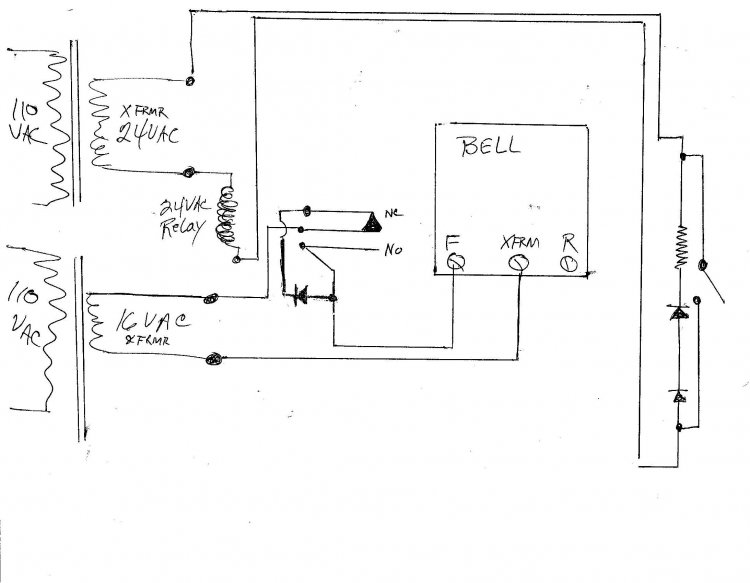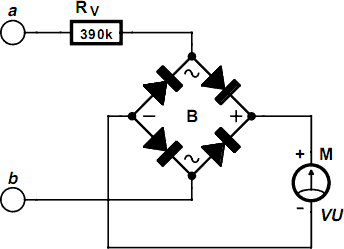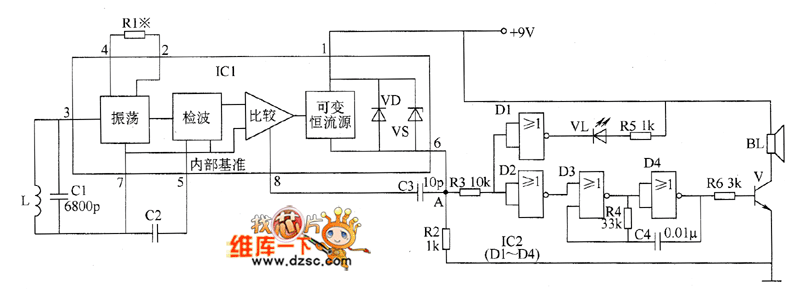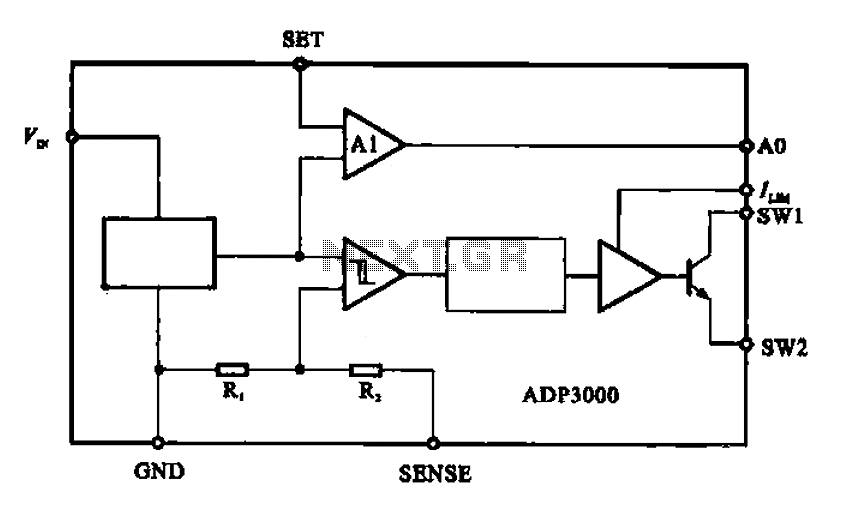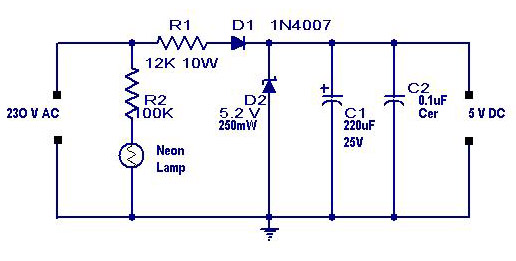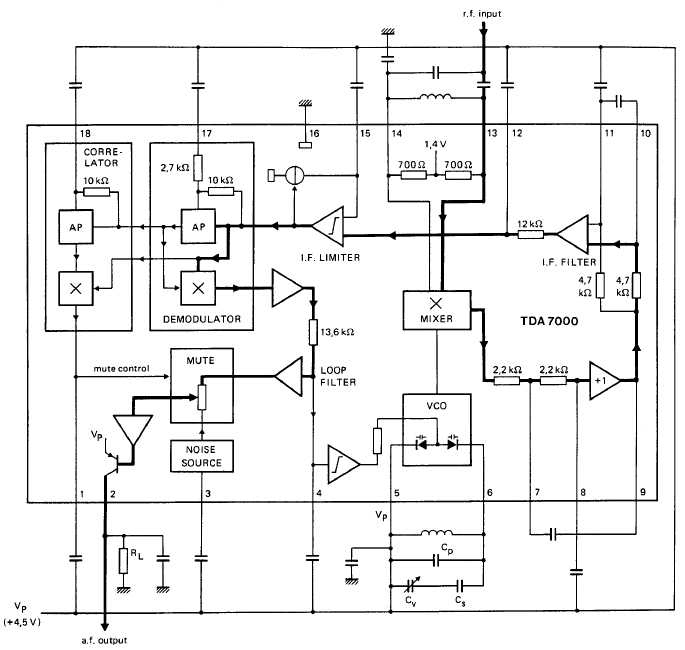
Full Wave Rectifier Circuit with Averaging Filter
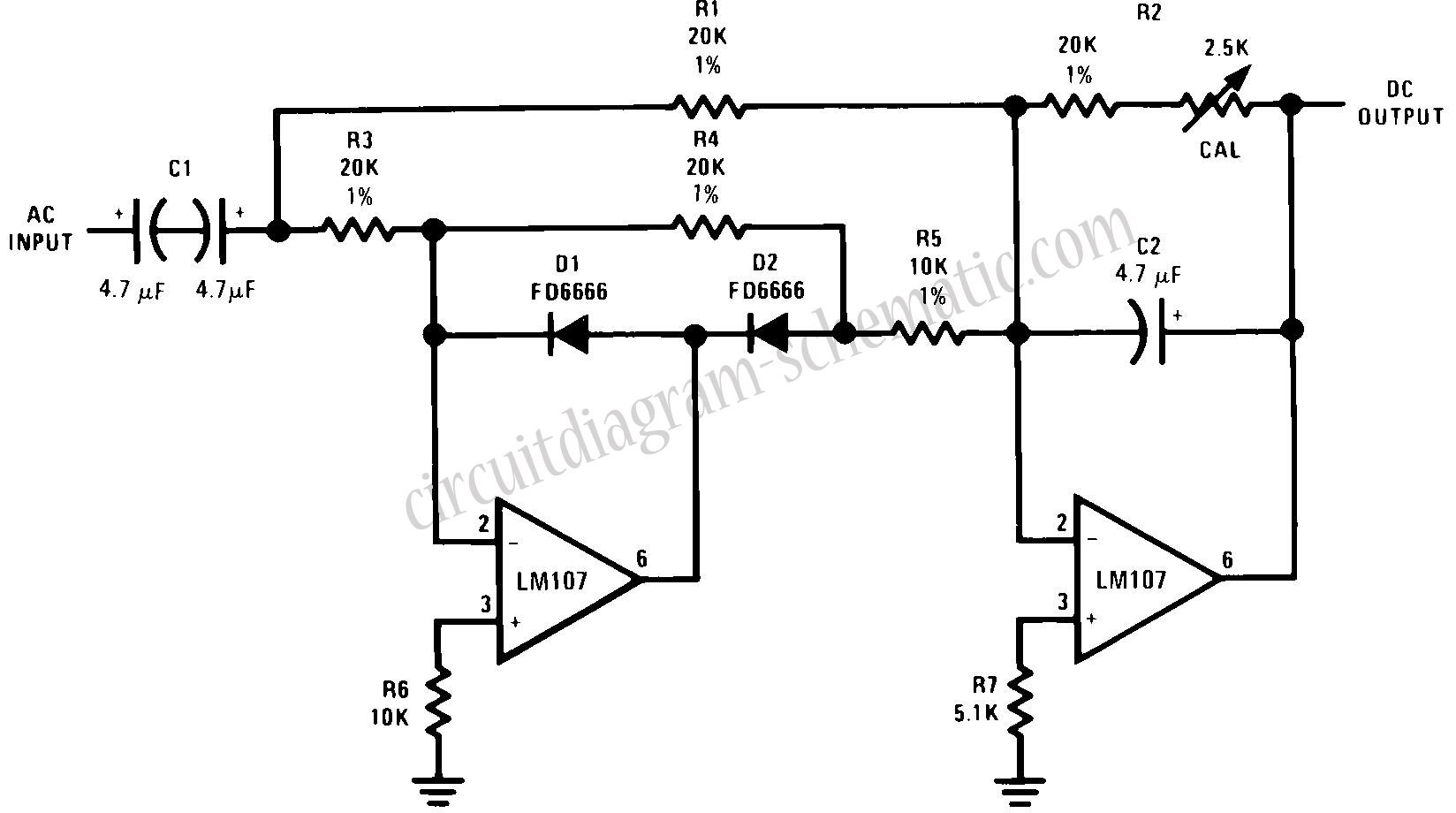
This circuit is an RMS-calibrated AC voltmeter that provides average readings. Removing capacitor C2 eliminates the averaging function, resulting in a precision full-wave rectifier, while removing capacitor C1 transforms the circuit into an absolute value generator. The operation of the circuit can be understood by examining the signal path for both negative and positive inputs. For negative signals, the output of amplifier A1 is clamped to +0.7V by diode D1 and is disconnected from the summing point of amplifier A2 by diode D2. Consequently, A2 operates as a simple unity-gain inverter, utilizing input resistor R1 and feedback resistor R2 to produce a positive-going output. For positive inputs, A1 functions as a standard amplifier connected to the A2 summing point through resistor R5. In this case, A1 also acts as a unity-gain inverter, using input resistor R3 and feedback resistor R5. The gain accuracy of A1 remains unaffected by D2 since it is included within the feedback loop. Positive current flows into the A2 summing point through resistor R1, while negative current is drawn from the summing point through resistor R5. Given that the voltages across R1 and R5 are equal and opposite, and considering that R5 is half the value of R1, the net input current at the A2 summing point is equal to and opposite the current through R1. Thus, amplifier A2 operates as a summing inverter with unity gain, yielding a positive output. The circuit functions as an averaging filter when C2 is connected across R2, with A2 operating similarly to a simple low-pass filter previously described. The time constant R2C2 should be significantly larger than the maximum period of the input voltage that is to be averaged. Capacitor C1 can be removed if the circuit is intended to serve as an absolute value generator, resulting in an output that represents the positive absolute value of the input voltage. The selected amplifiers must be compensated for unity-gain operation, and resistors R6 and R7 should be chosen to minimize output errors caused by input offset current.
The described circuit employs operational amplifiers (op-amps) for signal processing, specifically to measure and convert AC voltage signals into a readable format. The design includes two main operational modes: averaging and absolute value generation, depending on the configuration of capacitors C1 and C2.
In the averaging mode, capacitor C2 plays a critical role by forming a low-pass filter with resistor R2. This configuration smooths the output signal, allowing the circuit to represent the average value of the input AC signal over time. The choice of resistor R2 and capacitor C2 values is essential; the time constant (τ = R2 * C2) must be selected to ensure that it is significantly greater than the period of the AC signal being measured, thus effectively filtering out high-frequency components and providing a stable average output.
In the absolute value mode, the removal of C1 ensures that the output reflects only the positive magnitude of the input signal, regardless of its polarity. This is particularly useful in applications where only the magnitude of the voltage is of interest, such as in power measurements or signal conditioning where negative voltages may not be applicable.
The circuit's design emphasizes the importance of precision in component selection. The operational amplifiers must be chosen for their ability to maintain accuracy in unity-gain configurations, which is critical for minimizing distortion and ensuring the fidelity of the output signal. Resistors R6 and R7 are strategically selected to counteract any potential errors introduced by input offset currents, which can lead to inaccuracies in the voltage readings.
Overall, the circuit combines efficiency and precision in measuring AC voltages, making it suitable for various applications in electronics, including instrumentation and control systems.This circuit is average reading use rms calibrated AC voltmeter. Deletion of C2 removes the averaging function and provides a precision full-wave rectifier, and deletion of C1 provides an absolute value generator. Circuit operation may be understood by following the signal path for negative and then for positive inputs.
For negative signals, the o utput of amplifier A1 is clamped to +0. 7V by D1 and disconnected from the summing point of A2 by D2. A2 then functions as a simple unity-gain inverter with input resistor, R1, and feedback resistor, R2, giving a positive going output. For positive inputs, A1 operates as a normal amplifier connected to the A2 summing point through resistor, R5.
Amplifier A1 then acts as a simple unity-gain inverter with input resistor, R3, and feedback resistor, R5. A1 gain accuracy is not affected by D2 since it is inside the feedback loop. Positive current enters the A2 summing point through resistor, R1, and negative current is drawn from the A2 summing point through resistor, R5.
Since the voltages across R1 and R5 are equal and opposite, and R5 is one-half the value of R1, the net input current at the A2 summing point is equal to and opposite from the current through R1 and amplifier A2 operates as a summing inverter with unity gain, again giving a positive output. Here is a schematic drawing : The circuit becomes an averaging filter when C2 is connected across R2.
Operation of A2 then is similar to the Simple Low Pass Filter previously described. The time constant R2C2 should be chosen to be much larger than the maximum period of the input voltage which is to be averaged. Capacitor C1 may be deleted if the circuit is to be used as an absolute value generator. When this is done, the circuit output will be the positive absolute value of the input voltage. The amplifiers chosen must be compensated for unity-gain operation and R6 and R7 must be chosen to minimize output errors due to input offset current.
🔗 External reference
The described circuit employs operational amplifiers (op-amps) for signal processing, specifically to measure and convert AC voltage signals into a readable format. The design includes two main operational modes: averaging and absolute value generation, depending on the configuration of capacitors C1 and C2.
In the averaging mode, capacitor C2 plays a critical role by forming a low-pass filter with resistor R2. This configuration smooths the output signal, allowing the circuit to represent the average value of the input AC signal over time. The choice of resistor R2 and capacitor C2 values is essential; the time constant (τ = R2 * C2) must be selected to ensure that it is significantly greater than the period of the AC signal being measured, thus effectively filtering out high-frequency components and providing a stable average output.
In the absolute value mode, the removal of C1 ensures that the output reflects only the positive magnitude of the input signal, regardless of its polarity. This is particularly useful in applications where only the magnitude of the voltage is of interest, such as in power measurements or signal conditioning where negative voltages may not be applicable.
The circuit's design emphasizes the importance of precision in component selection. The operational amplifiers must be chosen for their ability to maintain accuracy in unity-gain configurations, which is critical for minimizing distortion and ensuring the fidelity of the output signal. Resistors R6 and R7 are strategically selected to counteract any potential errors introduced by input offset currents, which can lead to inaccuracies in the voltage readings.
Overall, the circuit combines efficiency and precision in measuring AC voltages, making it suitable for various applications in electronics, including instrumentation and control systems.This circuit is average reading use rms calibrated AC voltmeter. Deletion of C2 removes the averaging function and provides a precision full-wave rectifier, and deletion of C1 provides an absolute value generator. Circuit operation may be understood by following the signal path for negative and then for positive inputs.
For negative signals, the o utput of amplifier A1 is clamped to +0. 7V by D1 and disconnected from the summing point of A2 by D2. A2 then functions as a simple unity-gain inverter with input resistor, R1, and feedback resistor, R2, giving a positive going output. For positive inputs, A1 operates as a normal amplifier connected to the A2 summing point through resistor, R5.
Amplifier A1 then acts as a simple unity-gain inverter with input resistor, R3, and feedback resistor, R5. A1 gain accuracy is not affected by D2 since it is inside the feedback loop. Positive current enters the A2 summing point through resistor, R1, and negative current is drawn from the A2 summing point through resistor, R5.
Since the voltages across R1 and R5 are equal and opposite, and R5 is one-half the value of R1, the net input current at the A2 summing point is equal to and opposite from the current through R1 and amplifier A2 operates as a summing inverter with unity gain, again giving a positive output. Here is a schematic drawing : The circuit becomes an averaging filter when C2 is connected across R2.
Operation of A2 then is similar to the Simple Low Pass Filter previously described. The time constant R2C2 should be chosen to be much larger than the maximum period of the input voltage which is to be averaged. Capacitor C1 may be deleted if the circuit is to be used as an absolute value generator. When this is done, the circuit output will be the positive absolute value of the input voltage. The amplifiers chosen must be compensated for unity-gain operation and R6 and R7 must be chosen to minimize output errors due to input offset current.
🔗 External reference
